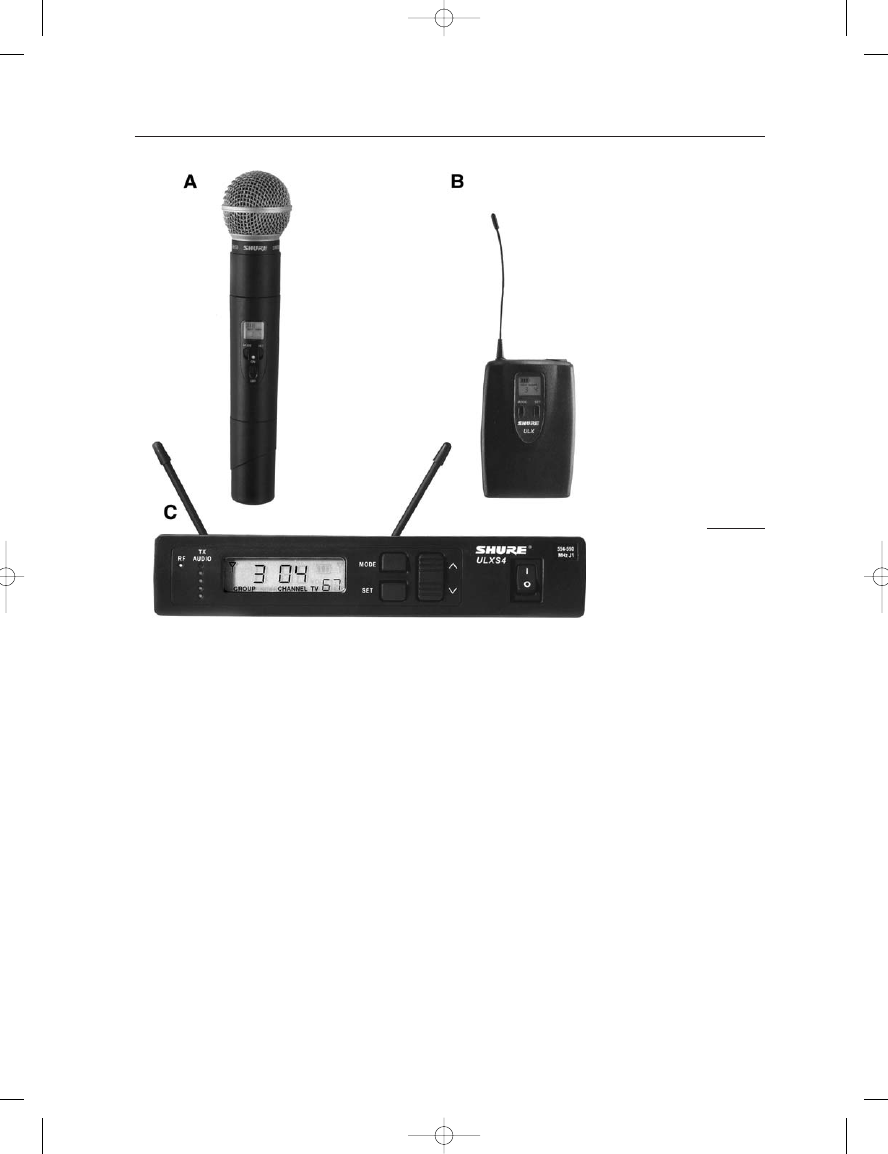ВУЗ: Казахская Национальная Академия Искусств им. Т. Жургенова
Категория: Книга
Дисциплина: Не указана
Добавлен: 03.02.2019
Просмотров: 17291
Скачиваний: 51

2. Sensitivity control. This is in effect a volume control that deter-
mines the level of the microphone signal reaching the transmitter
input. It can be adjusted for each user.
3. Power on-off. The power should of course be switched off when
the microphone is not in use in order to conserve battery life. In
actual operation however, the wearer should be instructed to leave
the microphone power on at all times in order to ensure program
continuity.
4. Microphone mute. The mute switch should be engaged by the
wearer only when there is a lull in use, so that normal handling
noises will not be transmitted. The wearer must of course be aware
of the microphone’s status so that it can be turned on when needed.
5. Status lights:
Microphone on/off.
Low battery condition. Normally, a blinking of the on/off light
is used to indicate low battery power.
Signal overload. Normally, a red light will indicate the presence
of too-high signal peaks, warning the user to talk at a lower level
or to readjust the sensitivity control.
THE MICROPHONE BOOK
148
FIGURE 9–6
Photograph showing a
typical wireless
microphone, bodypack
and receiver. (Photo
courtesy of Shure Inc.)
Earg_09.qxd 14/9/04 2:46 PM Page 148

THE RECEIVER
Today, receivers are fairly small, usually no more than one standard rack
unit high and one half-rack unit in width. While each unit can accom-
modate a pair of small diversity antennas, it is usually more convenient
to feed all receivers from a central diversity antenna pair with a split-
ter/booster unit, both of which may be located at the top of the rack
containing the receivers.
For each microphone or body pack in use there will of course be a
corresponding receiver. It is possible to assign multiple transmitters to
a single receiver, but it is obvious that only one transmitter can be used
at a given time.
Receivers vary in complexity and some will have more controls and
indicators than others. The following are considered essential:
1. Frequency selection. Must match that of the transmitter.
2. Squelch/mute threshold control. This control is used to set the RF
sensitivity of the receiver so that it will pick up the desired local
signal, but will mute when that signal is turned off.
3. Audio level. This control should be set for the desired output level
from the receiver. It is usually set for normal line output level.
4. Status lights:
Mute indicator. Indicates when the receiver is not picking up the
assigned transmitter.
RF level indicator. Indicates the level of incoming RF signal; a
persistently low level indicates the possibility of signal muting.
AF (audio frequency) level indicator. Indicates the level of audio
being fed downstream.
Diversity operation. Under normal operating conditions there
should be a continuous toggling action between the two indica-
tor lights, indicating that diversity decisions are being made more
or less randomly – which is the intended operation of the system.
POWER MANAGEMENT
Since all wireless microphones and body packs are battery operated,
there must be a good supply of fresh batteries available at all times.
Rechargeable batteries may, over time, represent a saving over the cost
of non-rechargeable batteries. However, the non-rechargeable batteries do
offer the benefit longer operating time and slightly higher output voltage
than the equivalent rechargeable units. Figure 9–7 shows the expected
active life of several battery types. You can easily see that, in a very long
evening’s show, if an actor, singer, or master of ceremonies is on stage
continuously for up to three hours, it will be essential to outfit the trans-
mitter with a standard alkaline non-rechargeable battery.
9: Overview of Wireless Microphone Technology
149
Earg_09.qxd 14/9/04 2:46 PM Page 149

For the average performance lasting about three-plus hours, any
rechargeable batteries that are in use will have to be replaced at some point
around the middle of the show, and this may not always be convenient to
do. For each rechargeable battery in use, it will be necessary to have two
others on hand – one freshly charged and the other being charged.
Furthermore, non-rechargeable batteries can be bought in bulk with con-
siderable cost savings. The bottom line here is to weigh the pros and cons
of rechargeable versus non-rechargeable batteries very carefully.
It is essential that one person be placed firmly in charge of all wire-
less microphone operations in a given application involving more than a
few microphones. The major responsibility is to ensure that there will
always be a supply of freshly recharged batteries and that there be a rig-
orous schedule for all users to have batteries replaced when needed as the
show goes on.
On a more global basis, the wireless specialist must also be aware of
what channels are actually available for use in all geographical venues in
which a road show may be scheduled. Also, the wireless specialist must
be aware of any other shows or events that may be scheduled in adjacent
show or sports facilities. Not all problems can be encountered and cor-
rected during an afternoon dress rehearsal. Patterns of RF interference
often change in the evening and must be anticipated.
PERFORMANCE ENVIRONMENTS
Essentially, wireless microphones rely on line-of-sight between transmitter
and receiver. The RF signal will travel easily through curtains and thin wall-
board materials provided that there is no metal mesh present. Ordinarily, a
wireless microphone should not be used within a distance of 3 m (10 ft)
of a receiver, due to the possibility of overloading the receiver’s first RF
amplification stage.
Normal usage may extend up to 300 m (1000 ft) if the venue is
relatively free of RF interference. In very large venues it may be advan-
tageous to have several transmitter/receiver groups, just to make sure
that excessively long distances will not be encountered. Likewise, it is
important to ensure that all “roving” microphones will perform well
when tested over their entire anticipated range of movement. Do not hes-
itate to reassign frequencies if transmission problems are encountered.
Often, moving the receiver rack a small distance will cure a transmission
THE MICROPHONE BOOK
150
FIGURE 9–7
Operating life of various
battery types. (Data
courtesy of Shure Inc.)
Earg_09.qxd 14/9/04 2:46 PM Page 150

problem. While the actual number may vary, it is generally possible to
use up to 30 wireless microphones simultaneously in a given venue. In
fixed installations remember that wireless microphones should be used
only where there is a need for user mobility. Microphones used solely at
pulpits, podiums, and lecterns should all remain wired.
FINAL COMMENTS
Do not treat the specification and application of wireless microphones as
an afterthought or as a trivial matter; there is too much that can go
wrong! Never make the mistake of believing that you can learn all you
need to know about these systems in one simple training session. We
strongly recommend that you acquire the wireless usage manuals avail-
able from many manufacturers. In particular we recommend the com-
prehensive guide written by Tim Vear (2003) for Shure Incorporated.
9: Overview of Wireless Microphone Technology
151
Earg_09.qxd 14/9/04 2:46 PM Page 151

C
H
A
P
T
E
R
1
0
MICROPHONE ACCESSORIES
INTRODUCTION
With the exception of handheld applications, microphones are rarely used
without accessories of one kind or another. Most accessories are used in
mounting the microphone in a stable configuration, ranging from desk
stands and flush mounts to large microphone stands or booms. Hanging
mounts are often used where stands are not appropriate. Under condi-
tions of wind or mechanical instability, wind screens and shockmounts
are essential. Numerous electrical expedients, such as padding (electrical
attenuation), polarity inversion, and the like may be conveniently met
with in-line adapters. Likewise, stand-alone phantom power supplies for
capacitor microphones are often useful. In this chapter we will cover the
entire range of accessories.
THE DESK STAND
The once familiar desk stand, shown in Figure 10–1A, has largely given
way to flush-mounted microphones in the boardroom and to the ubiqui-
tous telephone handset in modern transportation terminals. Many desk
stands today are considered too obtrusive and have been replaced by
models with a thin gooseneck extension and small capsule. This type of
assembly (Figure 10–1B) can be either mounted in a heavy base or per-
manently mounted on the working surface of a lectern. In either case, the
microphone itself can be easily positioned for the talker.
Purely for the sake of nostalgia, some late-night TV talk show hosts
may have a vintage microphone sitting on their desk. Look carefully; you
will note that the performer is usually wearing a lapel microphone!
FLUSH-MOUNTED MICROPHONES
The “mike mouse,” shown in Figure 10–2, is made of open cell foam
and is a convenient way to keep a small microphone positioned close to
Earg_10.qxd 14/9/04 2:47 PM Page 152